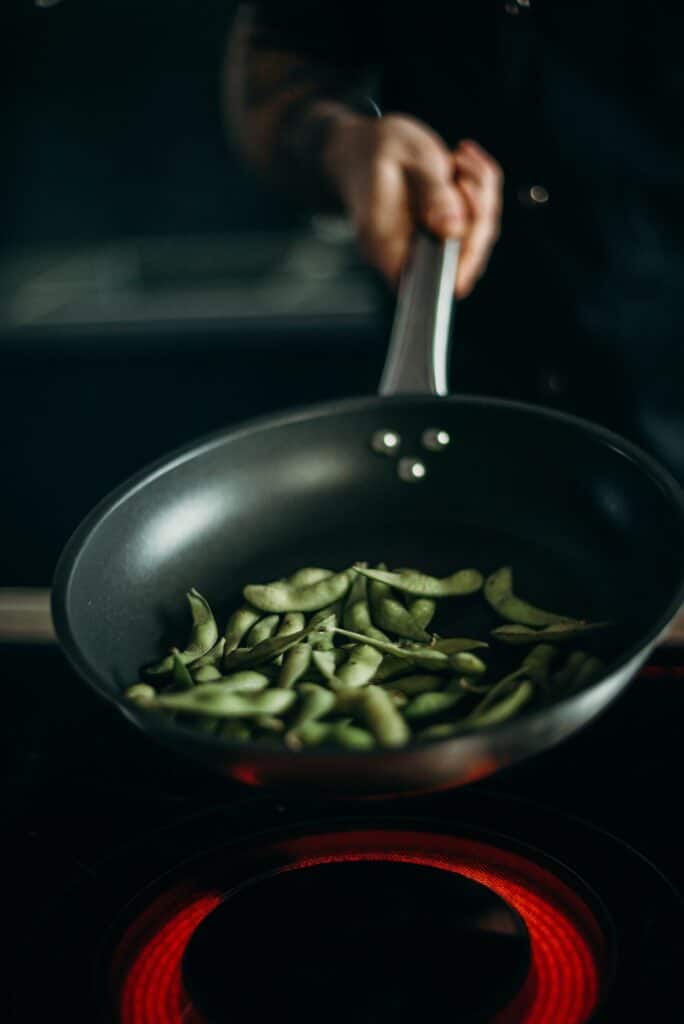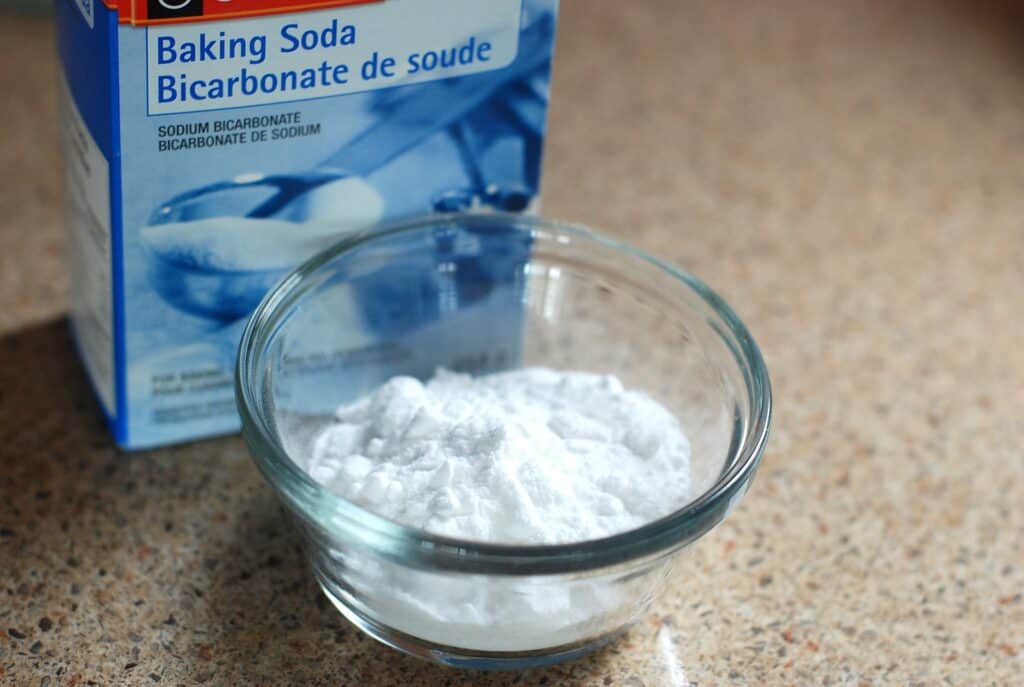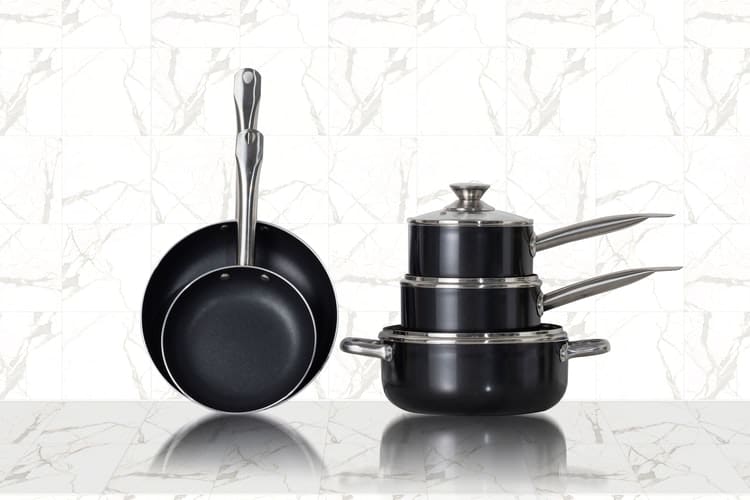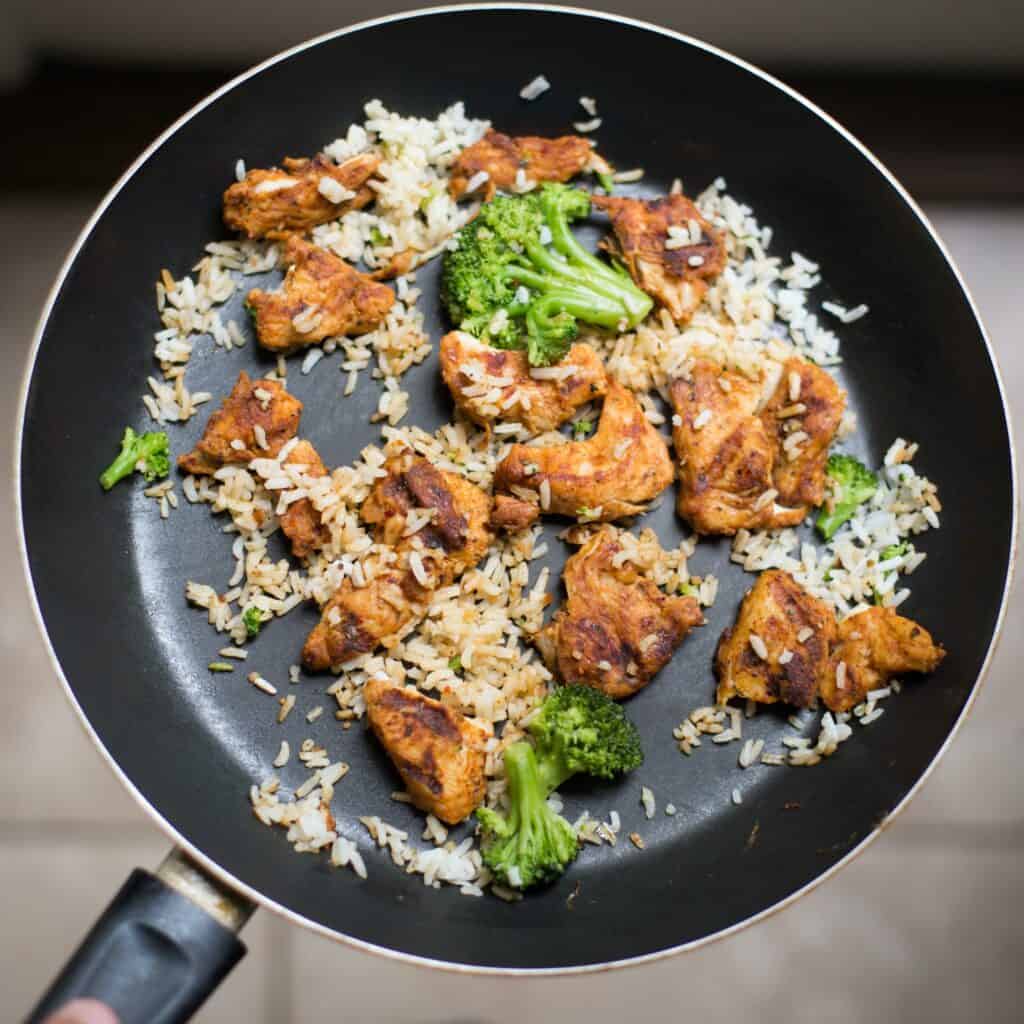As an Amazon Associate we earn from qualifying purchases.
One of the wonderful things about modern cookware is hard, durable, anodized aluminum. Another major plus is safety – aluminum cookware is much safer than PTFE and Teflon, as it won’t release chemicals into the air when you heat it on the stove. For many, anodized cookware was and still is my first “real” set of pots or pans.
Quick Navigation
How to Clean Hard Anodized Cookware
Taking care of your anodized cookware is pretty simple, and there is one main rule: Never use any metal on them. That is it, just don’t use metal utensils or cleaning products. Outside of that, hard anodized aluminum can last for years.

To clean hard anodized cookware, you typically want to do it right after the pan has cooled. Run it under warm water and clean with dishwashing soap and a sponge. If there is some food sticking, you can use the scouring side of the sponge.
If you have something seriously burnt to the bottom or sides of your anodized pan, cover it in baking soda and a tiny bit of water to cover and let it sit overnight before washing out. Never use steel wool or metal on your anodized cookware.
Here’s a quick outline of the steps to clean hard anodized cookware:
- Allow cookware to cool
- Rinse with warm water
- Soak with baking soda overnight if burned on foot
- Soap and Scrub
- Rinse
- Dry
Step 1: Allow Cookware to Cool
It is critical to let all cookware cool before washing. This step is critical not just for safety but also for physics. As metal expands and contracts as it heats and cools. The last thing you want for your cookware is to warp it by cooling it down too fast.
On anodized aluminum this is not as pronounced, but if you ever did this on enamel, you run a serious risk of cracking your expensive cookware. Worst off for anodized cookware, this can damage the riveting, making your cookware fall apart as you use it.
Step 2: Rinse With Warm or Hot Water
If you have ever washed a dish before, you know you need to add water to the soap to make it work. This step accomplishes two things:
- It is getting as much food and grease off the pan as possible
- It is allowing as much of that soap to come into contact with the metal as possible.
Do not ever rinse in cold water, as this can solidify the fat in the pan, turning into a waterproof layer and a pain to clean off.
Step 3: Soak With Baking Soda Overnight (Optional)
If you have burned on food you are going to need some help from baking soda. I have an entire section on this below, but in general, you need to know that baking soda will both help break up and lift burnt food off the pan.

Apply baking soda liberally and cover with just enough water to cover the burnt parts. If there is burning on the side of the pan, you can make a baking soda paste with water and apply that way.
Never mix baking soda with vinegar when applying to a pan – you are just making really expensive fizzy water.
Step 4: Rub Cookware Down With a Sponge and Soap
This should be the most familiar step for everyone, as this is the actual washing of the pan. I find the easiest way to apply the soap is to the sponge rather than directly to the pan.
This is so you don’t overestimate how much soap you need nor do you accidentally wash any of the soap off under the tap. You will need to apply some force to get food off, but if you are finding food still stuck on try the baking soda method in step 3.
Step 5: Rinse Again to Remove Soap
No one wants to eat or cook on soapy dishes, so make sure you use warm or hot water when rinsing to ensure all the soap is removed.
Step 6: Dry
Even though aluminum doesn’t “rust” like steel, tap water has a bunch of other junk in it that you don’t necessarily want sitting in your pan. You can dry your cookware with a soft clean towel, let it hang dry, or allow it to air dry upside down. Just make sure it is either hung dry or upside down so the water can fall out of the pan while it dries.
Materials Needed
As long as nothing is burnt to the pan you will just need some dishwashing soap and a sponge with a scouring side. If you did burn something in the pan expect you are going to need some baking soda as well.

What Is Hard Anodized Cookware?
Anodizing is the process of oxidizing a thin layer of a material to prevent it from natural corrosion (also an oxidizing force). In cookware, anodizing is performed on aluminum to produce aluminum oxide to about ~5nm in thickness. This thin aluminum oxide coating is non-porous and non-reactive giving some no stick and stainless properties to the product.
What Are the Benefits of Hard-Anodized Cookware?
The main benefit of hard-anodized aluminum cookware is it is fairly cheap to mass-produce and easier for the average cook to take care of than copper, steel, and especially cast iron and enamel.
Health wise, it has some huge benefits over PTFE and Teflon style non-stick coatings. Anodized aluminum does not release harmful chemicals into the air when heated.
Can I Put Hard Anodized Cookware in the Dishwasher?
Technically, yes, well-made hard-anodized cookware is dishwasher safe. A quick look at reputable producers like All-Clad clearly market their products as dishwasher safe.
Let’s break this down – there are 3 things you need to worry about with a dishwasher:
- Heat: Since anodized cookware goes on a stove, heat from a dishwasher is not a problem.
- Chemicals: The entire point of anodizing is to make the surface inert, so this is not a problem either.
- User Error: Will other dishes be hitting your anodized cookware while in the dishwasher? In this case, it’s all on your dishwasher tetris skills to load things properly.
In general however, you are always much safer cleaning it by hand where you know it will be safe from knicks (only one of which will ruin your cookware).
How to Clean Burnt Anodized Pans
There are numerous ways to clean burnt food out of an anodized pan. Remember, anodizing makes the surface inert, so anything sticking is most likely physically bonded through friction and tension, not chemically bonded.
The most reliable way to break up these physical bonds is with baking soda with just enough water to cover the burnt stuff. Let it sit overnight and then wash it out with warm soapy water. If the burnt stuff is on the side of the pan make a paste of baking soda and water and apply it.

While burnt food (carbon) is effectively inert (meaning it won’t react with anything), chances are the food is not entirely burned. By using an alkaline substance like baking soda, I can saponify (literally turn to soap) any fats in the burnt stuff (this both changes the physical makeup of the burned stuff and also reduces friction making it much easier to remove).
Never immediately apply vinegar with your baking soda. It will neutralize it and you just end up with fizzy water. You can apply vinegar after letting the paste sit, but you really should be able to just wash it out with soap and warm water.
Can You Use Steel Wool on Anodized Cookware?
Do not use any steel products on anodized cookware. Anodizing only affects the thinnest outer layer (~5 nanometers) of the cookware so any scratches to it will potentially leak harmful metals into your food.
Additionally, if your cookware has any additional kind of coating like PTFE (teflon) or other non-stick component then those pieces and flakes are also toxic.
It is recommended to use soft cleaning tools and products (sponges, plastics, silica, wood based products) with your anodized and coated cookware. Your basic rule of thumb is anything that is not metal is probably okay to use.
Can You Restore Hard Anodized Cookware?
If there is no external coating on top of the anodized cookware it is theoretically possible to re-anodize. Let’s be clear though, unless you have a lot of experience and equipment for an acid bath and controlled electrical currents, no one is doing this at home.
All that said, throw any damaged anodized cookware away. After all the main value proposition of anodized cookware is how much cheaper it is to produce than ceramic cookware.
Even if re-anodized, the cookware will not perform 1:1 with the original product. This is because the cook surface would no longer be flat and every ridge or dent is still a place for something to get stuck.
Conclusion
Modern anodized cookware has been an amazing invention, allowing for cheaper, durable, more mass produced cookware to be available for cooks everywhere.
Just make sure you keep them away from anything metal or steel and they will last you a long time. Even if you do mess one up, the low cost of aluminum cookware means you don’t have to sweat buying a new piece every now and then.
